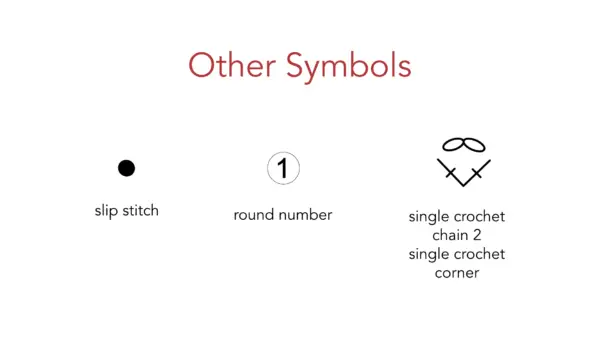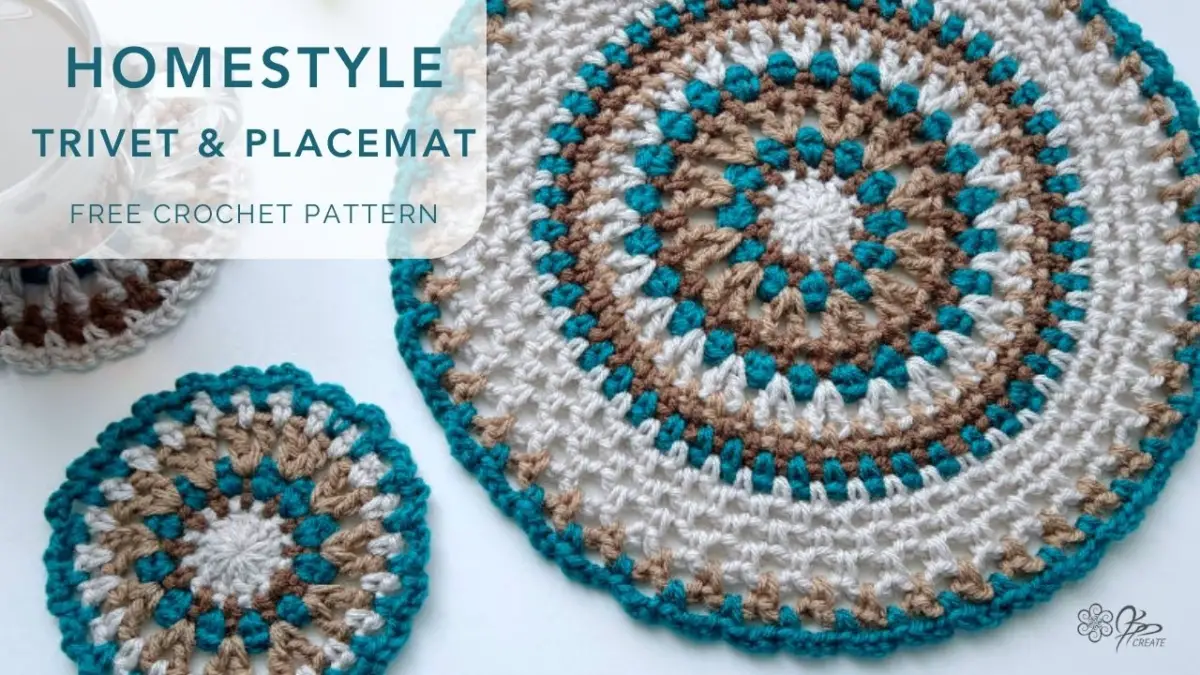Join me in this series as we demystify crochet symbol charts together. I’ll guide you through a step-by-step process while introducing you to commonly used symbols. We’ll tackle the Wispy Willow Granny Square in real-time, using just the symbol chart.
By the conclusion of this series, you will have gained a solid introduction to common symbols, and you will be well on your way to confidently reading crochet symbol charts for all your patterns.

The Stitch Symbols
Foundations: Crochet Symbol Charts
To start with let’s discuss the foundations. When you work in the round, you will need a foundation that creates a circle.
The two we are going to explore are the Magic Ring and a Chain Foundation.

Magic Ring: is used when you want to close up the center ring so there is no space. It is something like working all your first round stitches into a slip knot and then closing it up. In Part 2 of the series I will walk you through how to make a Magic Ring
Chain Foundation: These are the most common way to start a circular piece and can be made with any number of chain stitches. In our Square we will explore a chain 4 foundation. This is simply 4 chain stitches, slip stitches into a ring. Then we work Round 1 into this ring. The difference is mostly just that there will be a space in the center unlike the magic ring where you can close it up.
Start Here with Part 1 that explains the symbols and all the basics you need to get started.
Get The Free Wispy Willow Chart PDF Here
Beginning Chains: Crochet Symbol Charts
Every Round will start out with a Beginning Chain. The size of the chain, depends on the stitches that follow.
The four we will explore are:

Beginning Chain 1: This is used for starting a round of single crochet. It squares up that first single crochet stitch, but is not counted as it’s own stitch.
Beginning Chain 2: Used for a round of half double crochet stitches. This first chain 2 is vertical and counts as you first half double crochet stitch.
Beginning Chain 3: Used for a round of double crochet stitches. This first chain 3 is vertical and counts as you first double crochet stitch.
Beginning Chain 4: Used for a round of treble crochet stitches. This first chain 4 is vertical and counts as you first half double crochet stitch. You will also see this used if you have a round with double crochet followed by a chain 1 space, so the first chain 4 will then count as you first double crochet + chain 1.
Each of the Beginning Chain’s are vertical and relate to the height of the stitches used in the round.
In Part 2 we get started on the foundation and round 1
Stitches: Crochet Symbol Charts
Now we get into the symbols you will use the most. The basic stitches. The ones we will be using are:

Single Crochet: This symbol looks like a “plus” sign and is two equal length sticks that cross at a right angle at their centers.
Half Double Crochet: This is the first of the ” T ” shaped symbols. It is a simple ” T ” with NO cross sticks and is often shorter than the other ” T ” shapes due to the height of the half double crochet being shorter.
Double Crochet: Also a ” T ” shape but with one cross stick, often at an angle. slightly taller than the Half Double Crochet
Treble Crochet: The third ” T ” shape and this one has two cross sticks on it. Also slightly taller than the others
The ” T ” stem lengths will vary on a chart depending on the layout. Sometimes they will be longer than normal, since they are trying to point out what stitch or chain space to work into and may have to stretch (especially at corners) in order to do this.
In Part 3 we continue with Round 2 and 3
Get The Free Wispy Willow Chart PDF Here
Chain Spaces: Crochet Symbol Charts
These chain stitches are used to create space around your piece, unlike the Beginning Chains, they will be lying on their sides, or curved around a corner, or a picot shape.

Chain 1: a simple single chain, to create a slight space between stitches and often used as a simple way to increase.
Chain 2: a chain 2, gives a little more space and can create a slight lacey effect.
Chain 3: a chain 3 is often used as a bridge effect, to link shell stitches or other tall stitches while creating a lacey effect and keeping the piece balanced.
Corner Chain 3: Used to turn a corner. This will look curved on a chart, indicating you will be turning a corner. This can also be a chain 2 or a chain 4 depending on the size of the piece and the height of the stitches in the rnd.
In Part 4 we continue with Round 4 and 5
Other Symbols: Crochet Symbol Charts
Finally we will look at a few symbols that don’t fall into the other categories:

Slip Stitch: represented by a solid, single dot. This is most commonly used to join rounds, so will appear at the end of a round, sitting next to the stitch or chain you are to slip stitch into.
Round Number: Each round has a number, you will find these somewhere close to the beginning chain of the round and it will have a circle around it to make it stand out.
Corner Sc group: this is just a group of stitches that has been slightly altered to make it fit easily into a chart. Alot of groups are just short forms of common stitch techniques. This one is used at the corner and is a ( single crochet, chain 2, single crochet ) all worked into one stitch or chain space.
In Part 5 we continue with Round 6 and 7
We wrap it all up with Part 6 in rounds 8, 9 and 10 for the edging
Get The Free Wispy Willow Chart PDF Here
More Information on Hooks Sizes, Yarn Weights and Crochet Language
Crochet Chart Symbols see Craft Yarn Council
Hook Sizes see the Craft Yarn Council’s Page Here
For Standard Yarn Weight Information See this Page
A Handy PDF from Annie’s on the difference between UK and US Crochet Terms
A Nice Explanation from LoveCraft’s on The UK and US differences
Thanks for joining me and getting creative.
“I found I could say things with color and shapes that I couldn’t say any other way – things I had no words for.” – Georgia O’Keeffe




